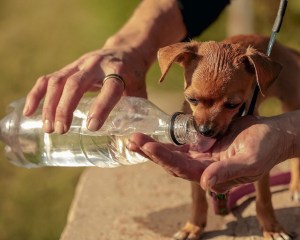Table of Contents
Key Takeaways
- Teacup dogs or dogs bred to be tiny are prone to conditions such as heart disease, low blood sugar, and bone fractures.
- Extra precautions need to be taken to prevent the dog from getting injured, when they are harder to see and more fragile.
- Plan to spend more at the veterinarian if you adopt a teacup dog.
Teacup dogs are tiny breeds of pups, sort of leaning to the “Aw, I wish they’d stay this small forever!” idea about puppies. Unfortunately, purposefully breeding animals smaller and smaller means their tiny size comes with big health issues.
If you purchase your pet from an unlicensed teacup dog breeder, you could find your troubles are just beginning. There are many teacup dogs in shelters and rescues as well. Before you add a teacup dog to your fur family, be sure you have the time and budget to provide a forever home.
Heart defects and diseases

Teacup dog breeds are prone to developing heart disease because of their genetic predispositions. Chronic valvular disease makes up 75% of all heart disease cases in these types of dogs. A heart murmur is often the first recognized sign, which may progress to heart failure as the valves weaken over time.
Signs of heart disease in dogs include rapid breathing, excessive panting, fainting, coughing, loss of appetite, and lethargy. If you notice any of these signs in your teacup dog, visit your vet immediately.
Stress
Dogs are creatures of habit and if car rides are not a normal part of their routine, they can be easily stressed by a trip to the vet. This is especially of concern in teacup dogs who are more fragile. Pet parents also frequently carry around their teacup pups, which can lead to separation anxiety or additional stress if they must be left home alone.
A stressed dog may try to hide or burrow out of sight. Excessive whimpering, barking, or trembling are other signs of stress. To reduce stress in your dog, provide a calm environment at all times. Loud noises and strange people are the primary stressors for teacup dogs, so try to keep the home environment as consistent as possible.
Hypoglycemia (Low blood sugar)

Because of their small size, teacup dogs are at an increased risk of low blood sugar if they go extended periods of time without food. Severe low blood sugar can lead to seizures and a coma if left untreated. To prevent this, ensure your pup has access to food throughout the day. If you notice any of the following signs in your teacup dog, consult a veterinarian immediately.
- Disorientation or confusion
- Low energy level
- Trembling
- Restlessness
- Seizures
- Unconsciousness
Liver shunts
A liver shunt in dogs is a birth defect where the liver’s major blood vessel directs blood around the organ instead of through it. The Yorkshire Terrier, Pug, and Maltese breeds are more prone to developing congenital liver shunts. The main sign of a liver shunt in dogs is failure to thrive, which leads to malnutrition, weakness, and stunted growth. You may also notice neurological abnormalities as ammonia levels build up within the blood due to liver dysfunction.
Treatment of choice for a liver shunt is surgery with hospitalization and supportive care. For dogs that cannot undergo surgery, they are managed medically. This includes feeding a low protein diet, providing medications to manage toxins in the blood, and administering antibiotics to support healthy gut function.
Hydrocephalus (fluid on the brain)
This condition literally means “water on the brain,” which refers to the buildup of cerebrospinal fluid inside the skull. This excess fluid puts pressure on the brain and can be present at birth or acquired later in life as a result of trauma or inflammation. Many of the teacup dog breeds are predisposed to this condition, which results in a dome-shaped head.
Clinical signs of hydrocephalus in dogs include an enlarged skull, altered gait, behavioral changes, difficulty learning basic commands, seizures, blindness, and circling. Treatment for hydrocephalus includes instilling a shunt within the brain, which drains the built-up cerebrospinal fluid into the abdomen. However, because this brain surgery is so expensive and specialized, most pet parents opt for medical management. Medications to control seizures and brain inflammation are commonly used. Diuretics may also help draw the excess fluid away from the brain. If the disease progresses or is severe, euthanasia may be the kindest option.
Incontinence
Teacup dogs have teeny tiny bladders to match their size, making constant bathroom breaks necessary. As we mentioned before, chronic stress can also lead to incontinence, as can other types of anxiety in dogs. Set a timer on your phone to remember your pup’s potty breaks. Teacup dog breeds’ small size also allows them to be house trained inside, whether in a dog litter box or a turf potty patch.
Skin redness or a rash is one symptom of incontinence, along with a bad smell and excessive licking. Dog diapers are one way to manage incontinence, which require changing just like a human baby’s. Never limit your dog’s water intake without consulting your veterinarian first, as dehydration can lead to secondary conditions like a urinary tract infection or hypoglycemia.

Bone fractures
Teacup dogs are as fragile as they look and are especially prone to bone fractures. There is not much supporting muscle surrounding their long bones compared to larger dogs, and their bones are quite tiny. Even a short fall or minor traumatic impact can cause a fracture. It is important to discourage these dogs from jumping off elevated surfaces, such as the couch or bed, to reduce their risks of fractures. Many fractures in teacup dogs are the result of an inattentive human stepping or tripping on them. Being mindful of where you are stepping, and using baby gates to restrict access to certain parts of the home can be helpful.
Signs of bone fractures in dogs include swelling and pain accompanied by limping, trembling, and whining. If these occur, you should stabilize the affected leg and transport your dog to your veterinarian for treatment.
Teacup dogs may not be the best type of dog for families, as rough handling from sticky fingers can lead to accidents. Small children may be less aware of a pint-sized pup underfoot; many fractures in teacup dogs are the result of an inattentive human stepping or tripping on the animal. Never leave any sized dog alone with a small child or baby, for the safety of both. Place baby gates or other barriers in front of ledges as an additional precaution to prevent pups from taking a tumble.
The content is not intended to be a substitute for professional veterinarian advice, diagnosis, or treatment. Always seek the advice of your veterinarian or other qualified health provider with any questions you may have regarding a medical diagnosis, condition, or treatment options.
With small size comes large medical bills, so be sure your lifestyle and budget can accommodate the breed of dog you’re bringing home. Getting a pet insurance quote should be the first item on every pet parent’s new puppy checklist! While pet insurance can help cut costs, you must be enrolled before a medical condition is diagnosed in order to receive coverage for it.









